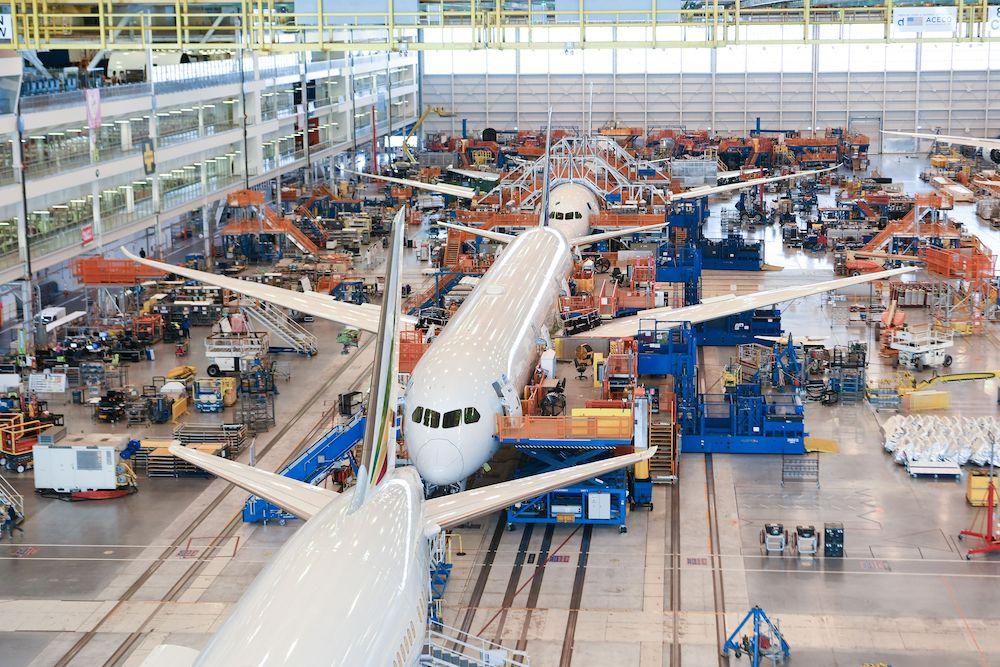Latest 787 Delivery Pause Rooted In Certification Data Error

A normally routine certification process is at the center of Boeing’s latest 787 delivery interruption, adding new uncertainty to the often-troubled program.
Deliveries have been halted because of what Boeing called an “engineering analysis error” linked to the redesigned forward pressure bulkhead supplied by Spirit Aerosystems. The issue, discovered within the last week and acknowledged publicly Feb. 23, was found as part of Boeing’s work to extend airworthiness limitations on 787 forward pressure bulkheads, the manufacturer confirmed. Boeing shared its findings with the FAA, which determined they did not comply with certification requirements.
“We are pausing deliveries while we update our analysis and submit any required certification deliverables to address the non-compliance,” Boeing said.
While forward pressure bulkheads are on the list of 787 components flagged with quality issues that led to a 14-month pause in deliveries, the erroneous certification data is not linked to inspection and verification work on the updated designs. Rather, it was part of the aircraft’s original certification package.
Boeing assigned a conservative four-year limit to the redesigned bulkheads installed on all 787s delivered since the August 2022 restart. The process, similar to what happens with an initial certification, includes follow-up analysis that usually extends initial limitations using modeling and other data. This step is where Boeing, using the original data as a baseline, found the error.
The FAA, which is signing off on each 787 before delivery, said it will hold off on approving any more customer hand-overs until it is “satisfied that the issue has been addressed.”
While the 2023 first quarter has not started well, Boeing is confident that its full-year 787 delivery target of 70-80 and monthly production rate of five per month by yearend are still in play. Given the company’s recent track record on meeting certification requirements and keeping programs on schedule, that may change, however.
Adding to the confusion is disagreement between Boeing and Spirit over the newest problem.
“We have provided all of the information that Boeing requested on the 787 over the last two years,” Spirit said in a statement late Feb. 23. “Based on the information we currently have and our interactions with Boeing to date, we believe it is too early to assert there was an ‘analysis error’ by Spirit.”
The supplier will “continue working with Boeing to better understand the specific issue and work cooperatively with them in order to resume 787 deliveries,” Spirit added.
Meanwhile, Spirit is confident that it is on pace to meet its 2023 787 program delivery commitments after working through unexpected ramp-up challenges following last August’s new-aircraft delivery restart. Those issues were linked to design changes that led to longer-than-expected production times for forward fuselage sections.
“We’re going to deliver off our production line eight units [this quarter] and slightly higher [numbers] in the second, third and fourth quarters,” Spirit CFO Mark Suchinski said at a Barclays investor event Feb. 23. “We’re on track to meet the 40 to 45 deliveries” in 2023, he added.
Boeing had been rolling out new 787s at a rate of 3-4 per month after customer deliveries resumed in August 2022. But the rate slowed to about 1 per month in December, data from consultancy Aero Analysis Partners shows. The ramp-down, coordinated with Spirit, started just before the Christmas holiday.
Boeing has not publicly confirmed the lower figure, but CFO Brian West recently acknowledged the production-flow change and suggested that Spirit’s rate is not back up to pre-slowdown levels.
“The supply chain has been firing at three per month,” West said at a Cowen investor event Feb. 15. “As it pertains to final assembly, we’ve had to take a little bit of a pause in that area in the near term to make an adjustment so that we can get the Spirit fuselage in a spot where it was more predictable.
“Our expectation is that they will get back to that three per month,” West continued. “And then as we move through the course of this year, be exiting the year closer to five per month.”
Suchinski underscored that Spirit met its target of 20 787 shipset deliveries in 2022 and is on pace to meet the stepped-up target range of at least 40 this year, including eight promised by April 1. He acknowledged that required engineering changes put in place to help correct production-quality issues mean the redesigned products—specifically forward cargo door assemblies—are taking longer to complete than originally anticipated.
“We started building new [fuselage] barrels post-August, and we produced four or five in the back half of 2022,” Suchinski said. “The time it’s taking from a build process is taking us longer than we previously had estimated,” he added, emphasizing that there have been “no new discoveries” of quality issues that need addressing.
The redesigned pressure bulkheads and addressing tiny gaps in cargo door assemblies are examples of dozens of issues Boeing and its suppliers had to address to ensure 787s are being produced to the company’s design specifications. In addition to the 14-month delivery pause, the issues forced Boeing to develop inspection and repair plans for 120 already built but undelivered 787s produced with the issues.
Confident the issues were largely behind it, Boeing in November unveiled a plan to ramp up 787 monthly production—which topped out at 14 per month before the recent global downturn--to 10 per month by mid-decade.

